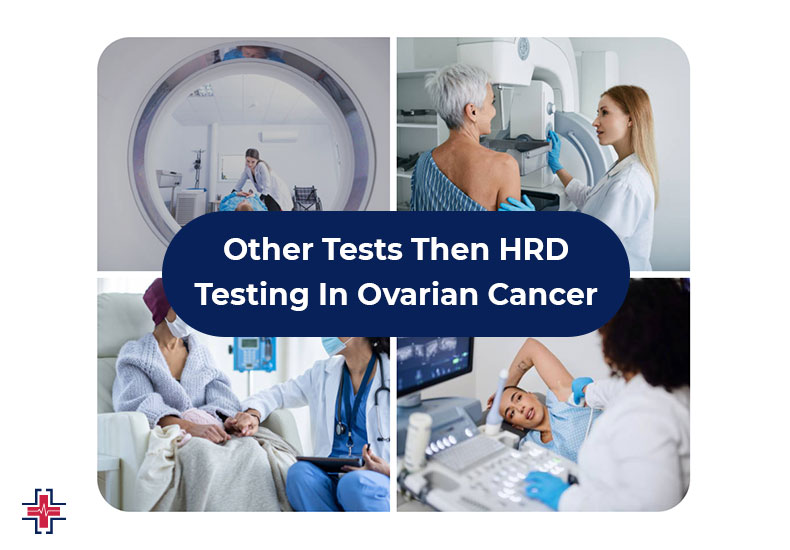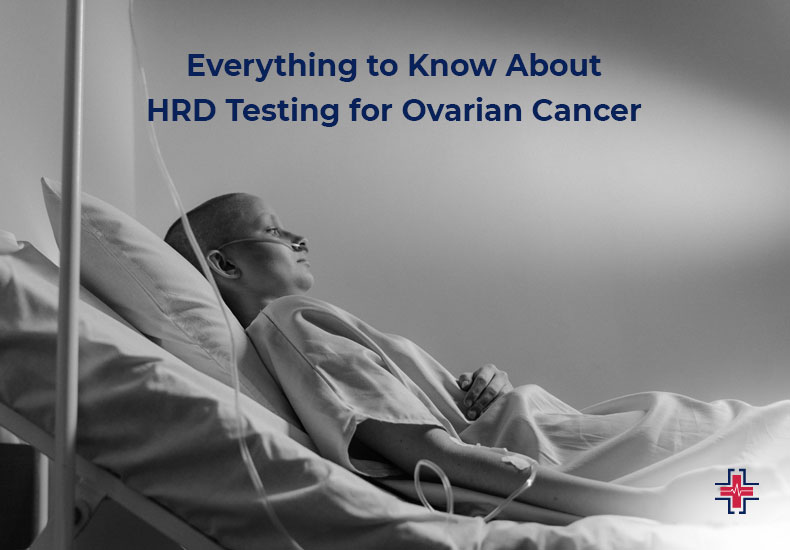In most advanced stages of ovarian cancer, homologous recombination deficiency (HRD) is a biomarker that is detected. Its existence may aid in the diagnosis and treatment planning of high-grade ovarian cancer.
In our bodies, DNA is continually being broken and repaired. The homologous recombination repair (HRR) mechanism is one of the pathways via which DNA damage repair happens.
Ten percent of ovarian malignancies have been linked to genetic alterations, more especially to mutations in the BCRA1 and BCRA1 genes.
What is HRD?
The intricate DNA damage repair process known as homologous recombination repair (HRR) uses a second copy of the gene as a template to repair double-strand breaks and interstrand cross-links (ICL) to restore the genome’s integrity.

In homologous recombination deficiency (HRD), double-strand breaks in DNA are not repaired by the body. This causes an over-reliance on alternative DNA repair methods that are more prone to errors.
Cancer is caused by a build-up of mutations, such as insertions and deletions, in the DNA that has been improperly or never corrected.
How Does HRD Testing for Ovarian Cancer Work?
Patients with ovarian cancer can receive diagnostic information through HRD testing. This information can help medical providers tailor their treatment plans.
BRCA1 or BRCA2 mutations and genomic scarring are checked for using HRD testing ovarian cancer. By displaying the long-lasting effects of genomic alterations brought on by a failure in DNA repair, these genomic scars serve as an indirect indicator of HRD.
A healthcare expert will determine whether a patient’s tumor is HRD-positive by computing an HRD score and measuring three different indicators of genomic instability. Among them are:
- Loss of heterozygosity (gLOH): Every gene has two alleles in humans. The permanent loss of an allele copy of a gene at a particular location on a chromosome that was contributed by one parent is referred to as a loss of heterozygosity.
- The number of allelic imbalances, or areas on a chromosome where two alleles of a gene Express at different levels in a cell, is known as the number of telomeric imbalances (TAI). Chromosome breakages are a type of genomic change known as large-scale transitions (LST).
When all are combined, it provides a more accurate indicator of a person’s overall prognosis for cancer than when they are taken separately.
Can You Tell Me What the HRD Test Entails?
To check for HRD, a sample of your tumor is required. This can be obtained by a biopsy or during ovarian cancer surgery. During a biopsy, a tiny sample of bodily tissue—a tumor—is taken so that it can be studied under a microscope.
Somatic testing is the term for this kind of examination. It only detects variations that are found inside the tumor. It is unable to detect variations that also exist in the germline cells—alterations in cells that are inherited from parents and found in every cell in the body. A variation may be found exclusively in the tumor in some individuals, whereas it may be present in both the tumor and the germline cells in others. Thus, a germline variant test ought to be’
Why Is This Test Done?
Usually, HRD testing in ovarian cancer diagnosis takes place either during or following the test.
HGSOC is rarely found in its early stages and has a high death rate. It is also the most prevalent type of epithelial ovarian carcinoma, which accounts for up to 90% of ovarian cancer cases.
As around 50% of HGSOC tumors are HRD-positive, HRD testing can help physicians determine your risk of getting this kind of cancer.
Furthermore, platinum-based chemotherapy and poly (ADP-ribose) polymerase inhibitors (PARP inhibitors) are effective treatments for cancers that test positive for HRD. Your care team can determine whether you are a candidate for this treatment and begin it as soon as feasible with the help of this type of testing.
Benefits of HRD Testing
The following benefits of HRD testing for patients with advanced ovarian cancer:

- Predisposition insights: By looking for germline mutations in the BRCA1/2 gene, HRD testing can determine a person’s family members’ chance of developing ovarian cancer. Additionally, it can assist in identifying women with ovarian cancer who may be at risk for developing other cancers.
- Prognostic insights: The test determines whether the tumor has variations that could lead to HRD and offers information into how the cancer will progress.
- Treatment insights: Testing plays a crucial role in directing and organizing a thorough treatment plan and establishing the potential benefits of targeted therapies such as PARP inhibitors.
When a tumor tests positive for HRD, certain medications, such as poly ADP-ribose polymerase (PARP) inhibitors, may be effective in treating it. An enzyme called PARP aids in DNA repair.
A targeted treatment called PARP inhibitors stops the enzyme from working in cancer cells, stopping them from fixing their damaged DNA and ultimately leading to their demise.
The most prevalent kind of epithelial ovarian cancer, high-grade serous ovarian cancer, affects about half of patients when they first have HRD.
PARP inhibitors are more likely to be beneficial for patients with HRD-positive cancers than for those with HRD-negative tumors. As a result, HRD testing helps determine which patients will benefit most from maintenance therapy following platinum-based chemotherapy and PARP inhibitors.
Testing for HRD: What to Expect
Those who receive a new ovarian cancer diagnosis are usually offered HRD testing. Various test approaches require various samples and look for distinct mutations.
One test that a physician could employ is somatic testing, also known as tumor testing. by testing, a physician will remove a sample of the tumor by surgery or biopsies and look at it under a microscope. They will assess the genetic makeup of tumor cells and look for mutations occurring inside the tumor.
A physician will additionally perform separate germline testing because somatic testing is unable to detect germline BRCA1 and BRCA2 mutations. This test looks for inherited mutations by analyzing DNA from samples of healthy cells, such as blood or saliva.
Somatic and germline tests provide valuable clinical data. To determine if a patient has a somatic or germline mutation in the HRD gene, the majority of physicians start with somatic testing and recommend germline testing.
Various tests that examine distinct aspects of genomic instability may be used to establish HRD status. An individual may have to wait 10–14 days for test results.
Treatment
Nowadays, a lot of medical professionals employ HRD as a biomarker when giving patients with ovarian cancer PARP inhibitors or platinum-based chemotherapy.
Typically, taxane is used in conjunction with platinum-based chemotherapy (cisplatin or carboplatin) following a patient’s tumor removal procedure.
Instead of using PARP inhibitors as a last resort after other treatments have failed, doctors now prescribe them as the first line of treatment for newly diagnosed patients. There are currently three PARP inhibitors licensed by the FDA to treat ovarian cancer:
- Niraparib
- Olaparib
- Rutaparib
Patients with platinum-sensitive recurrent ovarian cancer (ROC) respond well to these medications. Using maintenance PARP inhibitors improved progression-free survival in patients with ROC.
The Detection of Ovarian Cancer Is Easy?
Ovarian cancer is known as the silent killer because, because of its evasive symptoms, it frequently remains undiagnosed in its early stages.
Nonetheless, those who do exhibit early symptoms typically report the following symptoms:
- Increased frequency or urgency of urination
- Bloating
- Having trouble eating or feeling satisfied quickly
- Abdominal or pelvic aches
Less frequent symptoms could be:
- Constipation
- Exhaustion
- Upset tummy
- Stomach edema after losing weight
- Back discomfort
- Discomfort during intercourse
- Variations in a person’s menstrual cycle, such as excessive or erratic bleeding
For ovarian cancer, there is presently no single screening test available.
What the Results Mean
Your combined results from the LST, gLOH, and TAI tests determine your HRD testing score.
Regardless of whether you test positive for inherited BRCA1 or BRCA2 mutations, an HRD score of 42 or higher is regarded as positive and suggests that you’re a candidate for targeted treatment with PARP inhibitors.
If you test positive for BRCA mutations and your HRD grade is less than 42, you can still be a candidate for PARP inhibitor treatment.
Your doctor will go over your HRD rating and its significance in BRCA mutations.
Other Tests Then HRD Testing In Ovarian Cancer
Ovarian cancer cannot always be detected by genetic testing. Not every genomic scar can be identified with the same screening techniques, even in genetic testing.
Merely 10% of ovarian cancer cases are associated with a BRCA mutation. There is additional genetic evidence linking ovarian cancer to genes like ATM, BRIP1, and MSH2.

A genetic counselor could suggest further screening instruments, such as the following, to search for new genomic factors:
- Testing for the folate receptor-alpha (FR-alpha)
- Microsatellite instability (MSI) testing and NTRK genetic screening
These assays assess alterations in protein expression that could point to ovarian cancer-specific genetic mutations.
There isn’t a standard procedure for ovarian cancer screening. Your symptoms, family history, and other risk factors will be taken into consideration by your healthcare team when deciding whether and when to screen you for ovarian cancer.
Traditional Screening
Conventional ovarian cancer diagnostic techniques continue to be crucial for early identification and treatment.
Your physician might suggest diagnostic imaging tests like these:
- CT (Computerized Tomography)
- Magnetic resonance imaging (MRI) and ultrasound
- Radiography
- PET, or positron emission tomography
These instruments assist you in identifying abnormal tissue growth on your ovaries visually. They can also assist in determining whether the cancer has migrated from your ovary to other parts of your body.
Apart from diagnostic imaging, various other procedures can assist medical practitioners in determining the cancer’s stage or obtaining tissue samples. These procedures include:
- Biopsy
- Laparoscopy
- Paracentesis
Any test for ovarian cancer may be combined with a blood test.
Blood tests look for systemic alterations from cancer, such as aberrant hormone levels or out-of-range blood cell counts, as well as indicators of other tumor types.
What Does it Signify if the HRD Test Results for Tumor are Positive?
There is a greater chance of success with certain treatments if your tumor tests positive for HRD. PARP inhibitors are among them. They are a kind of targeted therapy that prevents cancer cells from using the PARP enzyme, which prevents them from repairing specific kinds of DNA damage. Cancer cells that test positive for HRD have a more difficult time mending themselves. PARP drugs cause more cancer cells to perish by further blocking this repair pathway.
Bottom Line
Your doctor can determine whether your HRR pathway is functioning normally by doing an HRD test for ovarian cancer. Your DNA damage is erroneously repaired when your HRR pathway malfunctions, leading to mutations that may promote the growth of cancer.
HRD is regarded as a reliable indicator of advanced ovarian cancer and HGSOC, even though not all ovarian tumors test positive for it.
Your doctor at hospital or nearest emergency care center can determine whether you could benefit from specific targeted medicines by doing an HRD test. You will be able to begin such therapies as soon as feasible thanks to this.
